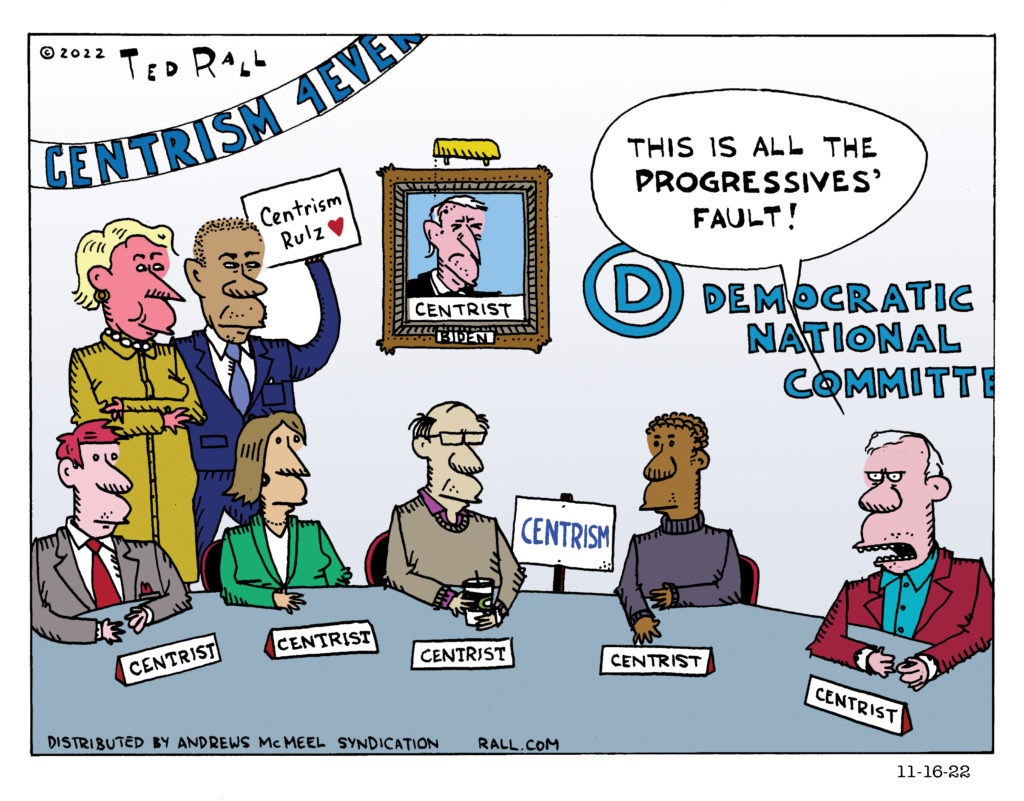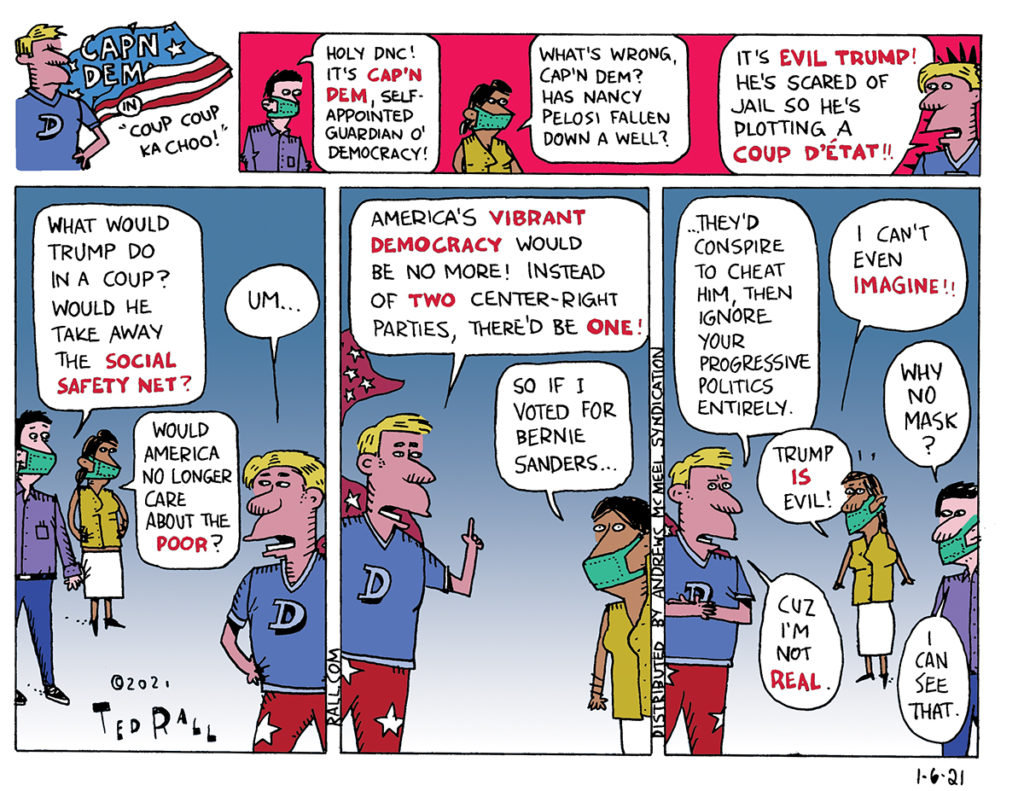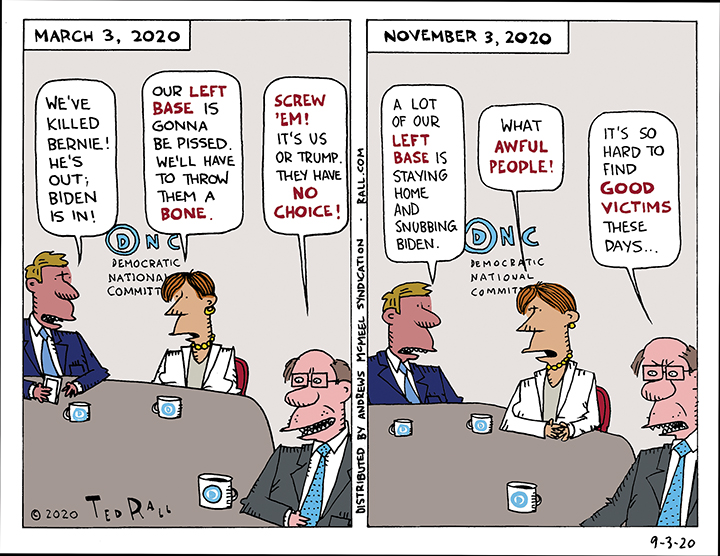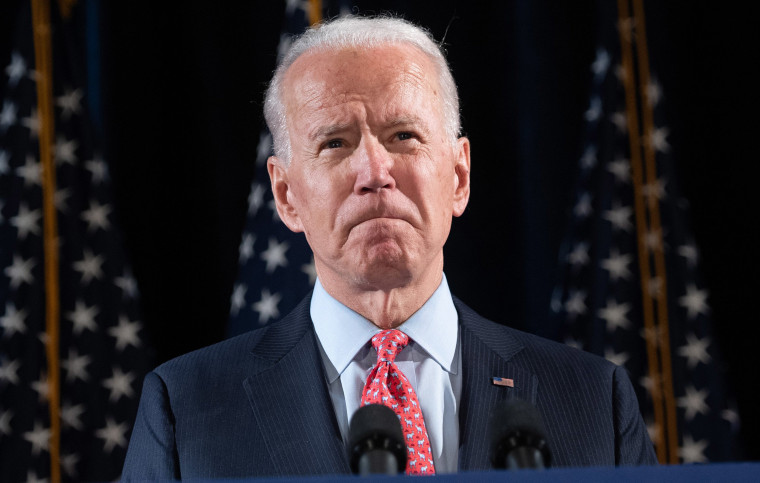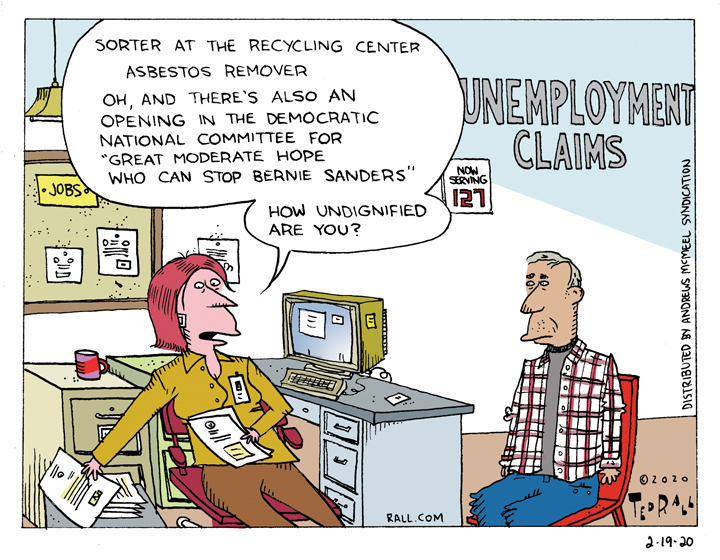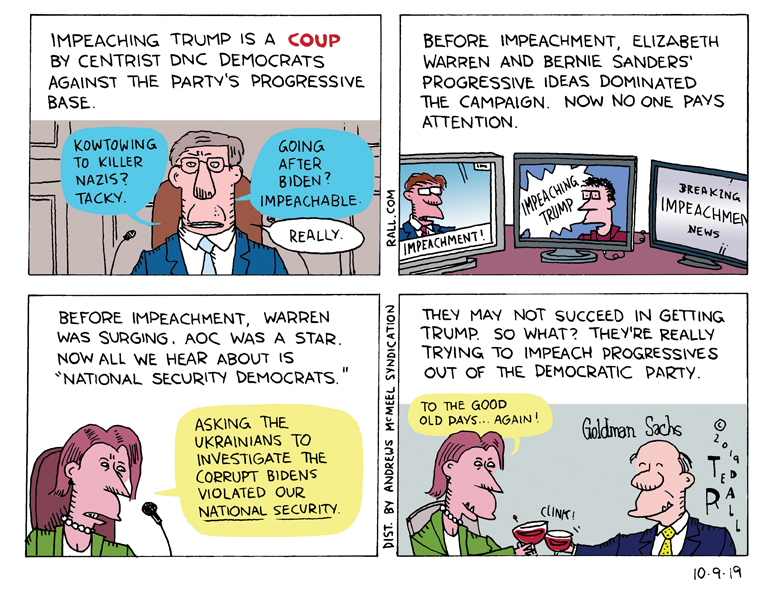As Democrats size up their losses and the future of the party, the last thing they consider is the possibility that they might bear some responsibility for discontent leading into the 2022 midterm elections. As usual, there’s a convenient whipping boy. As usual, the criticism couldn’t possibly be less justified.
Why Are Our Victims so Uncooperative?
On Super Tuesday, the Democratic National Committee and President Obama carefully coordinated the replacement of Bernie Sanders by Joe Biden as the Democratic frontrunner for president. The new progressives would be upset but didn’t care because they figured progressives would have to vote for Biden no matter what. Now that that’s not the case, they are upset that their plan is not working.
If Trump Wins, Don’t Blame Progressives. This Is on You, Centrists.
The corporate conservatives who control the Democratic Party are suffering from cheaters’ remorse.
The DNC and their media allies (NPR, CNN, MSNBC, New York Times, Atlantic Monthly, Vox, etc.) subverted the will of primary voters, undermining initial frontrunner Bernie Sanders in order to install the worst candidate of the 20 centrists in the campaign.
Now the power brokers are worried that the befuddled Biden, whom they touted as the Most Electable Against Donald Trump, will lose to him. Rather than take responsibility for their idiocy and force Biden to pull out of a race for which he is obviously physically and mentally unprepared, the corporatist sellouts are preemptively blaming the progressives who warned them about this exact scenario.
Sorry, right wingers. Biden is on you. You made him the presumptive nominee. If Trump wins again, it’s your fault.
Just as it was last time.
Establishment panic over Biden is most palpable in the pages of the official party organ of the Democratic Party, the Times. “While [Biden] has held consistent leads in most national and swing-state polls, they have not been altogether comfortable ones,” the paper noted on May 15th.
If Biden is to squeak by Trump in November, he requires a comfortable lead now. “A CNN poll released on Wednesday found Mr. Biden leading the president by five percentage points nationwide, but trailing by seven points among voters in crucial battleground states…for some Democrats, the results of the CNN poll again raised the specter that Mr. Biden could win the popular vote but lose the Electoral College, as Hillary Clinton and Al Gore both did.”
Historically, in May of a presidential election year Democrats need a lead of at least 10 points over their Republican rival in order to prevail in a general election. Republicans always close the gap during the last six months of a presidential race.
The Times is pushing Biden’s candidacy via two lines of argument. First, lesser-evilism. As columnist Frank Bruni wrote May 17th, he’ll “take Biden’s confusion over Trump’s corruption.” (Of course Biden is corrupt too.) Second, they claim, Biden should be acceptable. He isn’t Hillary Clinton. Due to the coronavirus crisis, Bidenites say, their man is willing to pivot to the left. (Never mind that progressive programs need to be in place before a crisis, not ramping up a year after it begins.)
The second argument is the easiest to shoot down. Biden has a decades-long track record of voting and governing to the right, including voting to invade Iraq for no good reason. Even now, as tens of millions of Americans lose their jobs and thus their health insurance, Biden refuses to join the rest of the industrialized world by endorsing single-payer healthcare. Progressives don’t trust Biden. They trust history. History proves Biden isn’t one of them.
Bruni’s argument involves magical thinking too. “At the end of the day, Biden can be trusted to do what Trump didn’t and won’t: stock his administration with qualified professionals. He could compensate for any supposed cognitive deficit with a surplus of talent,” Bruni says. There is no evidence, none, zero, zip, that this is true. Biden could validate that argument by announcing his cabinet nominations now. But he’s not.
Biden leaves progressive voters cold. That matters because the enthusiasm gap could decide the election. “Trump had a consistent edge over Hillary Clinton in enthusiasm [in 2016],” reported CNN’s Harry Enten. “His voters were 4 points more likely to say they were very enthusiastic in voting for him than Clinton’s were for her in the final ABC News/Washington Post poll, even as Clinton led overall. That enthusiasm advantage should have been one of the warning signals to the Clinton campaign. Trump’s current edge in enthusiasm over Biden is even larger. In a late March ABC News/Washington Post poll, 53% of Trump backers said they were very enthusiastic about voting for him. Just 24% of Biden backers said the same about their guy.”
If anything, the enthusiasm gap might widen as billions of dollars of stimulus payment letters bearing Trump’s signature hit voters’ bank accounts and he wraps himself in the trappings of the presidency while Biden sits in his basement trying to figure out how to use his computer camera. If I were Trump, I’d be planning my second term.
Let’s not forget how we got here.
When Bernie Sanders announced he was running again, Democratic-aligned media outlets said he was too old. “Mr. Sanders would be 79 when he assumed office, and after an October heart attack, his health is a serious concern,” the Times said in its absurd editorial joint endorsement of Amy Klobuchar and Elizabeth Warren.
Then, when Bernie emerged as frontrunner for the nomination, corporate media presented him as an existential threat. Head-to-head polls showed he was at least as electable as his rivals, yet “journalistic” organizations stated, without evidence, that a left-wing Democrat couldn’t beat Trump. Headlines proliferated:
“Bernie Sanders Can Still Be Stopped.”
“The Stop Sanders Movement Has Gone Public.”
CNN even compared Sanders to the coronavirus.
Remember all those “Can Obama Be Stopped?” headlines from the 2008 primaries. Me neither. When it came to Bernie, pseudo-liberal media didn’t pretend to be objective.
The DNC went after him like crazy.
Bernie Sanders won the key Iowa caucus but Democratic vote-counting chicanery cheated him out of the PR for his win. Party insiders believe that Barack Obama personally arranged for Beto O’Rourke, Amy Klobuchar and Pete Buttigieg to endorse Joe Biden the day before Super Tuesday. Speaking of which, Sanders won California, the biggest state—but the vote count mysteriously took days, denying him a big headline and an accurately optimistic delegate count in media coverage.
They’re still at it. At this writing party leaders are trying to prevent an embarrassing protest vote against Joe Biden in New York by fighting in court for the right to delete Bernie Sanders from the state’s mail-in primary ballots.
A Times headline from February 20th proved prescient: “Democratic Leaders Willing to Risk Party Damage to Stop Bernie Sanders.”
They got what they wanted.
(Ted Rall (Twitter: @tedrall), the political cartoonist, columnist and graphic novelist, is the author of the biography “Bernie,” updated and expanded for 2020. You can support Ted’s hard-hitting political cartoons and columns and see his work first by sponsoring his work on Patreon.)
A Premature Postmortem of the Bernie Sanders Campaign

Establishment media is ridiculing Bernie Sanders for stating some simple truths: establishment media was out to get him, the DNC was out to get him and young voters who support him haven’t been good about showing up at the polls.
But that doesn’t mean that Bernie Sanders didn’t make mistakes. So let’s take a look at those.
No matter what happens between him and Joe Biden, and it isn’t over yet, Sanders deserves credit for some remarkable achievements. In the face of formidable establishmentarian opposition, Jewish, with a speaking manner that is anything but conventional in U.S. politics, relying only on small individual donations and promoting a political agenda many Americans would consider radical, Bernie Sanders currently controls 42% of the Democratic primary vote against a recent sitting vice president. Much of his agenda, including making college affordable, increasing the minimum wage, and improving the healthcare system, has become mainstream Democratic Party policy after many decades during which the party didn’t even pretend to give a damn about normal people. Bernie Sanders is running an issue-based campaign, not one based purely on personality. Even if he loses, historians will mark this election as evidence of the strength of progressive and left-leaning electoral politics.
But he’s not perfect. There are things that he could have/could still do better.
Politics is first and foremost about framing, and Sanders isn’t great at it. “Medicare for All” is meaningless to millions of Americans who have had no contact with Medicare and don’t know anything about it. “Free healthcare” would have been easier to understand and would not have turned off or confused union members who already have decent healthcare plans. “Free college tuition,” on the other hand, tells too little of the story. Sanders’ plan only helps low-income college students but many voters seem to still think that he wanted to use their taxes to help out children of wealthy people. The “Green New Deal” hasn’t been defined or well-publicized beyond the fact that it would be expensive.
Sanders’ plan for student loan forgiveness was also presented in a problematic fashion. Many Americans don’t have college degrees; they wondered, why should we pay for those who do? Many other Americans went to college, took out student loans and then paid them back. Why shouldn’t millennials do the same? There are good answers to those questions: millennial student debt is many factors higher than Generation X and Baby Boomer debt because tuition has skyrocketed at a rate much faster than inflation. Student loan forgiveness would stimulate the economy by freeing up young people to buy cars and homes. People who already paid their loans should have been added as beneficiaries of his plan so that they didn’t feel like suckers due to a simple accident of birthdate. Most importantly, Sanders should not have proposed student loan forgiveness without coupling it to a free college tuition program and/or job retraining program for people who are older and don’t have college degrees or need retraining in order to retool for the 21st century.
Speaking of costs, I found it endlessly frustrating that Bernie Sanders never seemed able to clearly answer the question of how he would pay for his proposals. Generally, he should simply have said: “I’ll take it out of the Pentagon budget.” Maybe this wasn’t true. If it wasn’t true, he should have made it true. Not only is the defense budget bloated, most Americans, including people who favor strong military, know about the $800 toilet seats. I’m not sure why he didn’t bash the military.
He also hasn’t been good about explaining Medicare for All. What he should have said was, everyone is going to pay less for healthcare, so much less, that even though your taxes will go up a bit, you’ll still come out way ahead. And if you got hit by something catastrophic like cancer, it would all be covered. Instead, he talked about how European countries somehow managed to pay for national healthcare plans. He’s right about that, but Americans have been told that Europeans pay high taxes. He needed to explain in plain language that that would not happen here.
He ignored my advice to own and explain his self-described “democratic socialist” label. He probably assumed that it would be more of a problem in the general election against Donald Trump, but what he underestimated was the Democratic Party’s long history of red bashing as well as the well-established fact that other people will define you if you don’t do it yourself. He should have followed the example of JFK when he gave a speech assuring Americans that he would not take orders from the pope as a Roman Catholic. Sanders should have given a speech entirely about democratic socialism.
Some things, it’s hard to do anything about. A campaign has the candidate that it has with a personality that he or she comes with. Bernie Sanders has an underlying vulnerability and warmth that his tendency to bellow often covered up. The media had a field day portraying him as a guy who likes to yell a lot. This is where something like “The Man from Hope” video that the Bill Clinton for President campaign created would have come in handy. A biographical look at Bernie’s roots in Brooklyn, his childhood struggling in a working-class family and the premature death of his mother due to poor healthcare would have helped to humanize a very human person.
Images of him being manhandled by cops during his participation in the civil rights movement of the early 1960s couldn’t have hurt him with African-American voters who ended up turning out for Joe Biden.
Of course the biggest mistake Sanders made may not have been a mistake at all. He ran inside the Democratic Party. They were never going to let him have the nomination.
He had to know that.
(Ted Rall (Twitter: @tedrall), the political cartoonist, columnist and graphic novelist, is the author of the biography “Bernie.” You can support Ted’s hard-hitting political cartoons and columns and see his work first by sponsoring his work on Patreon.)
Corporate Crap That Doesn’t Kill Bernie Just Makes Him Stronger

On January 19th the New York Times oddly co-endorsed Senators Elizabeth Warren and Amy Klobuchar for the Democratic presidential nomination. Two days later, the key New Hampshire primary showed Warren down four points. Bernie Sanders’ surge continued. What happened?
To the extent that they ever did, the editorial boards at corporate-owned media outlets no longer seem to be helping the candidates they support. But I think it goes further than that. In a Democratic Party increasingly dominated by insurgent progressives, authenticity (or the perception thereof) is a politician’s most valuable asset. The approval of “mainstream” establishment entities has become a curse. The imprimatur of an officialdom widely seen as hopelessly corrupt dilutes a candidate’s reputation for authenticity, independence and the voters’ belief that he or she will stand up for we the people over the powers that be.
Much to the frustration of ruling elites, Bernie Sanders keeps gaining support despite repeated attempts to sandbag him. It began, of course, with a well-documented campaign by the Democratic National Committee to cheat Sanders out of a fair shot at the nomination in 2016. Though less brazen, the sympathies of the DNC, still dominated by Hillary Clinton allies, remain evident in the current cycle. As in 2016, Democratic-aligned media outlets rarely mention Sanders other than to frame him as an elderly fringe wacko. The “Bernie Blackout,” featuring graphics of TV polls where Sanders’ name had been excised, became so ridiculously obvious that it got its own Reddit.
The last few weeks have been especially instructive. There was the infamous sandbagging of Bernie Sanders at the hands of a CNN moderator. “Have you stopped beating your wife?” became, seconds after Sanders issued a categorical denial, “why did you tell Elizabeth Warren that you did not believe that a woman could win the election?,” a statement that wouldn’t be sexist if he said it and that runs counter to everything he has said and done over the last 40 years.
Next came the bizarre New York Times two-fer endorsement of Warren and Klobuchar, which included the demonstrably false claims that Bernie Sanders is hard to work with in the Senate and refuses to compromise. This was quickly followed by the news that Hillary Clinton, the nation’s least popular political figure, told a Hulu documentarian that “nobody likes” Sanders, the most popular, and that he’s a “career politician.” As opposed to herself and her husband?
In the bubble-wrapped imaginations of ruling elites like Clinton and the editors of the New York Times, the hoi polloi care deeply about what they say and think. They think we take their lead.
Reality is quite opposite.
It’s not that we don’t listen. We do. We pay attention to what Those In Charge say and what they want us to do—so that we can do the exact opposite.
Contempt for our “leaders” is one of the key reasons Donald Trump won the presidency. “To the extent that people are using Trump as a way of venting about their general unhappiness, trust is irrelevant,” Stanford University political scientist Morris Fiorina observed during the summer of 2016. “They’re just trying to send a message that they’re tired of being taken for granted and screwed by both sides.”
People wanted to send another message, albeit a childish one, to the elites: we hate you. 14% of Americans have a “great deal” of confidence in the news media. Congress’ approval rating is 27%. Last time Gallup bothered to check, Hillary was at 38%.
Americans’ disdain for their masters was placed in sharp relief by polls that showed that many Trump voters would have voted for Bernie Sanders had he been the Democratic nominee and that one out of ten Bernie Sanders’ primary supporters ended up voting for Donald Trump in the general election. Trump and Sanders were the change candidates in a change year. And 2020 is even changier.
We are witnessing political jiu-jitsu. The more viciously that neoliberals attack Bernie Sanders, the higher progressive estimations of Sanders’ authenticity rises.
Many on the left, me included, have held doubts about Bernie Sanders. We worry that he isn’t far left enough, especially on foreign policy. After all, he’s OK with drone assassinations, was pretty much silent about the Israeli invasion of Gaza, praised the illegal assassination of Osama bin Laden that denied justice to 9/11 victims, and has not proposed specific numbers by which he would cut the Pentagon budget.
Even on domestic issues, Sanders’ forte, he is weaker than we would like. The $15-an-hour minimum wage he is pushing for now would have been OK when he started working on it years ago, but due to inflation $20 or $25 an hour would make more sense now. By global standards, Sanders is no radical. He’s a garden-variety liberal—the Democratic Party under FDR.
Fortunately for him, reactionary goons like the New York Times remind us that whatever his shortcomings Sanders is still the best game in this very right-wing town, the farthest left Democrat to have presented himself for our consideration in the last 40 years.
If Hillary Clinton and CNN and MSNBC hate Bernie so much, maybe he’s all right.
It is increasingly likely that Bernie Sanders will become the Democratic nominee and perhaps President of the United States. If and when that happens, when this “democratic socialist” takes the oath of office, he ought to give a shout-out to the clueless enemies who made his victory possible.
(Ted Rall (Twitter: @tedrall), the political cartoonist, columnist and graphic novelist, is the author of “Francis: The People’s Pope.” You can support Ted’s hard-hitting political cartoons and columns and see his work first by sponsoring his work on Patreon.)
The Impeachment of Trump is a Coup d’Etat by DNC Centrists Again
Democrats would like to think that they are all united around the goal of impeaching Donald Trump. But when you scratch the surface what you find is that the impeachment of Donald Trump is less about getting rid of a sitting president and more about regaining control of the Democratic Party from the insurgent progressives who have taken it over since Bernie Sanders.
I Told You So: Only Idiots Believed in Russiagate
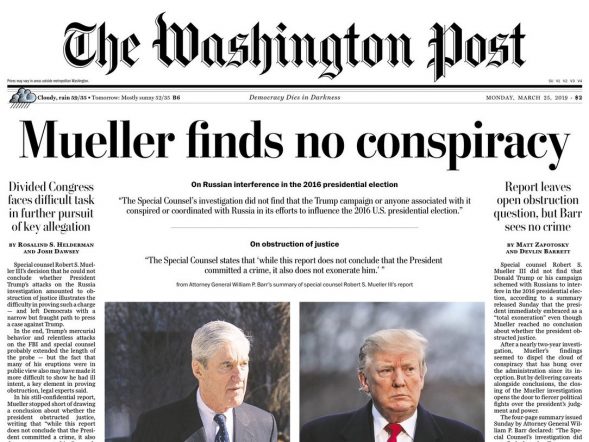
There they go again.
In 2002 and 2003 corporate media idiots speculated that secular socialist Saddam Hussein might give nukes that he didn’t and couldn’t have to radical Islamists who wanted to kill him. That story wasn’t true. Worse than that, it couldn’t have been true. I said it over and over and over. So did others.
But we skeptics were outsiders. Corporate media’s strict idiots-only hiring policy keeps journalists-as-stenographers, propagandists and broken-brain logic-haters employed by censoring those of us who are always right. The idiots’ idiotic lies about WMDs justified a war that left more than a million Iraqis dead.
Corporate media didn’t fire their idiots after the WMD fiasco. Why would they? They were in the war business and the suck-up-to-government business. Had they been in the truth business, losing their credibility might have mattered.
Idiots gonna idiot. So it’s no surprise that in 2016 the same corporate media morons fabricated another conspiracy theory so outlandish that not only was it obviously untrue, it could not possibly have been true—and that it would again have devastating real-world consequences.
Russiagate was a propaganda campaign waged by the Democratic Party and its media allies with a daily blizzard of overheated speculation that Russia installed Donald Trump as its stooge by hacking the 2016 presidential election. Several years and millions of dollars later, special counsel Robert Mueller has concluded that it didn’t happen.
Of course it didn’t happen. It couldn’t have happened.
As I wrote last year: “You’re asking us to believe that Trump’s people met with Putin’s people, not to discuss Trump’s sleazy real estate developments in the former Soviet Union, but to encourage Russian hackers to break into the DNC, steal Hillary’s emails and funnel them to WikiLeaks with a view toward angering enough voters to change the outcome of the election in Trump’s favor. Trump doesn’t even read one-page memos. Yet we’re being asked to believe that he supervised a ridiculously complex Machiavellian conspiracy?
“WikiLeaks didn’t get the DNC documents from Russia or any other state actor. They got them from a disgruntled pro-Bernie Sanders staffer at the DNC. Anyway, the intelligence community — you know, the friendly folks at the CIA, FBI and NSA whom Democrats worship the way Republicans revered firefighters after 9/11 — says whatever Russian hacking occurred did not affect the outcome of the election.
“Then there’s this: Trump didn’t actually want to win. Why would he go to such lengths to steal something he didn’t want?”
As Chris Christie pointed out January 28th, how the hell could a shoestring operation like the Trump campaign, which was “just trying to figure out how to get field people hired in places like Pennsylvania” be so internationally sophisticated as to “run some sort of Tom Clancy operation”?
My colleague Matt Taibbi writes, and he’s right: “Nobody wants to hear this, but news that Special Prosecutor Robert Mueller is headed home without issuing new charges is a death-blow for the reputation of the American news media.” Whatever credibility U.S. media still had after pimping those imaginary Iraqi WMDs, The Los Angeles Times allowing its stock to be sold to the LAPD and then taking orders from the police, and “experts” repeatedly reporting that Donald Trump had no chance of winning, lies in tatters.
The media idiots’ WMD BS cost a million-plus Iraqis their lives. Their Russiagate crap has vastly increased the chances that Trump will win reelection. Russiagate will make it all but impossible to impeach the bastard as he deserves and as the country desperately needs.
As I said on the radio after the Mueller news broke: “Business corruption would have been, should have been the focus of Democrats looking for legal means to remove this president. That’s the low-hanging fruit; that’s where something actually happened. Instead, they went after the president for something he didn’t actually do, and so they look really foolish, and Trump is going to beat the Mueller report over the heads of the Democrats all through next year, and it’s going to be hard for the Democrats to put this behind them.”
Trump is a corrupt real estate magnate with ties to the mafia and sleazy autocrats around the world. Anyone out to get him should have started by following his misbegotten money. Instead Democrats tried to do three things at once: get Trump, destroy U.S.-Russia relations to provoke a new Cold War that would profit the military-industrial complex and explain away the bankruptcy of Hillary Clinton’s brand of centrist corporatism.
Democrats are now turning their attention to the New York-based investigations of Trump and his business affairs by U.S. Attorneys. The president faces significant legal jeopardy on several fronts, including abusing a charitable organization to evade taxes and the likelihood that his hush-money payoffs to Stormy Daniels violated federal campaign finance laws. When he leaves office, Trump might even face jail time.
But none of that matters. Trump is so old and fat he’ll probably die before facing prosecution. The real threat to Trump from New York is current and political. Thanks to Mueller’s exoneration on Russiagate, Trump is largely politically inoculated from the New York stuff even if the Department of Justice files major charges. “Just another witch hunt,” he’ll say—and voters—not just his base—will nod their heads. The media will go on and on about wrongdoing that under normal circumstances would amount to one hell of a scandal—but who will listen other than partisan Democrats?
The second Trump Administration that just became likelier will hasten the destruction of the planet by pollution and climate change, widen income and wealth disparity and gut the Affordable Care Act. The U.S. system may never recover. All because the corporate media idiots went after a serial criminal for the one crime he didn’t commit.
Wanna know the richest irony? Trump knew how this would turn out. He knew what the Mueller Report would say. For two years he’s been watching DNC mouthpieces like MSNBC’s Rachel Maddow rant about Russiagate. He knew he’d use those clips for one attack ad after another.
Actual collusion! Democrats and their media outlets conspired to install Donald Trump as president in 2020.
(Ted Rall, the cartoonist, columnist and graphic novelist, is the author of “Francis: The People’s Pope.” You can support Ted’s hard-hitting political cartoons and columns and see his work first by sponsoring his work on Patreon.)
SYNDICATED COLUMN: What Do the Democrats Want? No One Knows.

In the 1970s, when I was a kid, I asked my mother to explain the difference between the two major parties. “Democrats,” she explained, “are the party of the working man. Republicans represent big business.”
She was a Democrat, obviously. Still, I’m sure Republican families had their version of my mom’s binary, perhaps something along the lines of: “Republicans believe in less government and more hard work. Democrats want high taxes and welfare.”
The two-party system was easy to understand.
Now it’s a muddled mess — especially if you’re a Democrat.
Today’s Democratic Party relies on big corporations, especially big Wall Street investment banks, for campaign donations. The old alliance between the party and labor unions is dead. Democrats support trade deals that hurt American workers. When the economy tanked at the end of the last decade, President Obama left laid-off workers and foreclosed-upon homeowners twisting in the wind; he bailed out the banks instead. Hillary Clinton, who supported the TPP trade deal before she was against it, promised bankers she’d be their friend if she won. Whatever the Democrats are now, they’re not the party of working Americans.
So what is the Democratic Party now? What does it stand for and against?
I honestly don’t know. I’m obsessed with politics. So if I don’t know what Democrats want, it’s a safe bet no one else does, either.
“It’s all well and good — and really very satisfying — to harp constantly about the terribleness of Donald Trump,” observes New York Times columnist Gail Collins. “But people need to see the Democratic line on the ballot and think of something more than Not as Dreadful.”
Yes they do.
Failure to articulate an affirmative vision of what she was for, not just against, was largely to blame for Hillary Clinton’s devastating defeat. Trump Is Evil and Dangerous wasn’t enough to win in 2016. It probably won’t be enough for 2018 either. Yet party leaders still haven’t begin to say how they would address the problems voters care about.
Like healthcare. The Clintonistas, still in charge of the Democrats despite their incompetent stewardship, believe that Obamacare will survive because the Republicans’ Trumpcare alternative is unpopular even with Republicans. But they’re wrong. In one out of three counties, there is only one insurance company in the local healthcare “exchange.” Zero competition guarantees skyrocketing premiums and shrinking benefits. The collapse of Obamacare makes healthcare the #1 concern for American voters.
What would Democrats do about healthcare if they were in charge?
As far as I can tell, nada.
House Democratic Leader Nancy Pelosi’s website brags about Obamacare and its achievements. “House Democrats,” it says, “continually work to implement and improve health care reform to ensure that the best healthcare system in the world only gets better.” Newsflash to Ms. Pelosi: Actually, the U.S. has the worst healthcare system in the developed world.
When it comes to healthcare, Democrats are just like the Republicans on global warming. They won’t admit there’s a problem. So how can they offer a solution?
They don’t. Even though 58% of American voters want a European-style taxpayer-subsidized single-payer system, the Democratic Party platform does not propose significant reforms to Obamacare.
The wreckage of deindustrialization in the nation’s heartland is widely viewed as key to Trump’s surprise win. So what is the Democrats’ plan to create jobs, increase wages and help victims of the opioid epidemic?
Aside from “Trump sucks,” Democrats don’t have much to say.
“We will create jobs that stay in America and restore opportunity for all Americans, starting with raising the minimum wage, expanding Pell grants and making college tuition tax deductible,” the party said in a statement a few days before Election Day 2016. Sounds great! But details are hard to come by.
Last year when it mattered, $225,000-a-speech Hillary asked workers to settle for a $12/hour minimum wage. Now, finally, Democrats are officially endorsing Bernie Sanders’ $15/hour. But it really should be at least $22/hour. And anyway, how would a minimum wage increase, or Pell grants, or tax-deductible tuition, “create jobs”? They wouldn’t. We need a big WPA-style federal hiring program. A law mandating that evil outsourcing companies like Facebook start hiring Americans wouldn’t hurt. But the Dems won’t get behind either.
When Democrats do have something to say, it’s trivial and small-bore, like making college tuition tax deductible. Why not go big? Did you know that the U.S. could make four-year college tuition free for the price of the ongoing war against Iraq?
Why are the Dems so lame? Suspect #1 is the lingering rift between the Sanders and Clinton wings of the party. “There is this grassroots movement voters’ arm of the party, and the more corporate, institutional part of the party. And the movement arm is tired of the institutional part telling us the only place for us is in the streets,” says Nebraska Democratic Party Chairwoman Jane Kleeb, a Sanders supporter. A party split by a civil war between a populist left and a corporatist right can’t articulate an inspiring platform of exciting solutions to American’s big problems. A purge, or a schism, would fix this.
Trump is already one of the most unpopular presidents in history. Going against him ought to be easy. But Democrats are about to find out — again — that people won’t vote for you unless you give them a good reason to get off their couches and drive to the polls.
(Ted Rall (Twitter: @tedrall) is author of “Trump: A Graphic Biography,” an examination of the life of the Republican presidential nominee in comics form. You can support Ted’s hard-hitting political cartoons and columns and see his work first by sponsoring his work on Patreon.)

